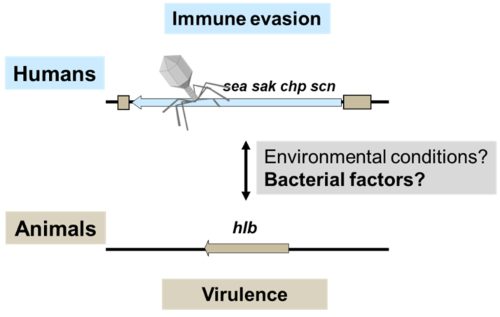GROUP WOLZ / Project WO 578/13-1
Molecular cross-talk between Sa3int phages and their Stapylococcus aureus host
Most Staphylococcus aureus isolates from humans carry Sa3int phages, whereas invasive and animal isolates tend to lose these phages. Sa3int phages encode several human-specific, immune-modulatory molecules and integrate into the bacterial hlb gene, coding for the sphingomyelinase Hlb. Thus, both insertion of the phages into and excision from the bacterial genome have the potential to confer a fitness advantage to S. aureus. How the S. aureus host modulates the life cycle of its temperate phages remains largely unknown. Putative bacterial factors are likely detrimental for the phage life cycle and certain S. aureus strains are more prone than others to support phage replication and/or excision. Thus, the genetic make-up of the host strains might determine the speed at which certain strains can achieve host adaptation. We aim to decipher the molecular mechanisms regulating the transition of Sa3int phages from a lysogenic to “active lysogenic” or to the lytic phase.

Principal Investigator(s)

Apl. Prof. Dr. Christiane Wolz
Universität Tübingen
Interfaculty Institute of Microbiology and Infection Medicine
Auf der Morgenstelle 28
72076 Tübingen
Tel: 49 7071 2974648
E-Mail: christiane.wolz@uni-tuebingen.de
PhD student(s)
TBA
Publications
- Rohmer C, Dobritz R, Tuncbilek-Dere D, Lehmann E, Gerlach D, George SE, Bae T, Nieselt K, Wolz C. Influence of Staphylococcus aureus Strain Background on Sa3int Phage Life Cycle Switches. Viruses. 2022 Nov 8;14(11):2471. doi: 10.3390/v14112471.
- Ingmer, H., D. Gerlach, and C. Wolz. 2019. Temperate Phages of Staphylococcus aureus. Microbiol Spectr 7. https://www.ncbi.nlm.nih.gov/pubmed/31562736
- Rohmer, C., and C. Wolz. 2021. The Role of hlb-Converting Bacteriophages in Staphylococcus aureus Host Adaption. Microb Physiol 31:109-122. https://www.ncbi.nlm.nih.gov/pubmed/34126612
